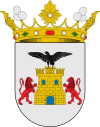Tobarra facts for kids
Quick facts for kids
Tobarra
|
||
|---|---|---|
|
municipality
|
||
|
Church of the Assumption
|
||
|
||
| Country | Spain | |
| Autonomous community | Castile-La Mancha | |
| Province | Albacete | |
| Comarca | Campos de Hellín | |
| Area | ||
| • Total | 324.96 km2 (125.47 sq mi) | |
| Elevation | 661 m (2,169 ft) | |
| Population
(2018)
|
||
| • Total | 7,738 | |
| • Density | 23.8122/km2 (61.673/sq mi) | |
| Demonym(s) | Tobarreños | |
| Time zone | UTC+1 (CET) | |
| • Summer (DST) | UTC+2 (CEST) | |
Tobarra is a town and a municipality (a type of local government area) in the province of Albacete in Spain. About 7,700 people lived there in 2018.
Tobarra is well-known for a few special things. It's famous for its "Moniquí" apricots, which are a type of fruit. The town is also known for its drum processions, called tamboradas. These are big events where many people play drums.
Another important tradition is the Holy Week celebrations. These events are so special that the Spanish government has called them of "National Tourist Interest." This means they are very important for visitors to see.
During Holy Week, there is a special statue of Jesus that can move. On Good Friday, this statue gives a blessing from a hill called Mount Calvary. Around 30,000 people often gather to watch this. After a trumpet sounds, the drums become quiet. Then, the Christ statue makes a blessing gesture in all four directions.
Other important parts of Tobarra's Easter celebrations include the "Descent from Paso Gordo." This happens on the afternoon of Good Thursday. The "Cierre del Tambor" (closing drum ceremony) is also a big event. It takes place at midnight on Easter Sunday.
Contents
A Look at Tobarra's Past
The area where Tobarra is located has a very long history. People lived here even before the Romans came to Spain. Tools and spears from prehistoric times have been found. There are also ancient graves from the Iberian people in the Santa Ana valley.
The name Tobarra comes from the Arabic word "Tabarrah." The town was important even in Roman times. A Roman road that connected two big cities, Complutum and Carthago Nova, was changed to pass through Tobarra. This shows how important the town was back then.
During the time of the Visigoths, a small church was carved into the rock. It was near a quarry that was used for many centuries.
When Muslims lived in the area, they built a castle and a mosque. They also created a large system to bring water to farms. Some of these old wells still provide water today. For many years, this area was the most important fruit-growing region in Albacete.
Changes in Control
In 1243, a prince named "Infante Alfonso" (who later became Alfonso X of Castile) took control of the area. However, Tobarra soon became independent again.
Later, Ferdinand IV of Castile gave Tobarra special rights. These rights were confirmed by kings and nobles for many years.
In 1324, an army from Granada attacked Tobarra. They took some people as slaves. At this time, Tobarra was becoming part of a powerful region called Señorío de Villena. In 1476, Tobarra officially became part of the Spanish crown.
Important Events in History
On Easter Sunday in 1766, Tobarra was the second place in Spain to protest against food shortages. This happened during the Esquilache Riots. The Marquis of Esquilache, who was a powerful leader, even slept in Tobarra the night before he was sent away from Spain.
In 1812, French soldiers led by General Soult burned the town. This happened when they were leaving the area of Murcia. Tobarra had to be rebuilt almost completely.
In the 20th century, the Spanish Civil War caused a lot of damage. Many cultural treasures in Tobarra were destroyed. However, some important religious statues were saved. These included the head of the "Ecce Homo" image and the "Virgen de los Dolores" sculpture.
Around 1950, Tobarra had its largest population, with almost 14,000 people. After that, the government focused on growing bigger cities. Tobarra then had to find its own ways to grow and develop its economy.
What to See in Tobarra
Tobarra has many interesting places to visit.
- Museum of the Drum and Holy Week: This museum is called Museo del Tambor y Semana Santa. It is located in a 17th-century building that used to be a church, called the Hermitage of the Virgin.
- Monument to the Drum: This monument is called "La Evolución." It was created by a local artist named Jesús D. Jiménez Ramírez.
- Church of Our Lady of the Ascension: This church is known as Iglesia de Nuestra Señora de la Asunción. It was built between 1546 and 1616.
- Sanctuary of Christ of Antiquity and the Virgin of the Incarnation: This special place is called Santuario del Cristo de la Antigua y Virgen de la Encarnación. It has been recognized as a national historical and artistic monument since 1981. Inside, you can see a beautiful wooden ceiling and painted murals from the 1700s.
Next to the Sanctuary, you can see the old ruins of a Muslim fortress. From there, you can also see a tower known as Ojos del Diablo, which means "the Devil's Eyes."
Other interesting sights include the Town Clock and the Convent of the Franciscan Order of Saint Joseph. There is also an ancient stone church from the Visigoth era called Alborajico. Nature lovers can visit the lagoon of Alboraj and the salt marshes of Cordovilla. The tower of El Castellar in Sierra is also worth seeing.
See also
 In Spanish: Tobarra para niños
In Spanish: Tobarra para niños



